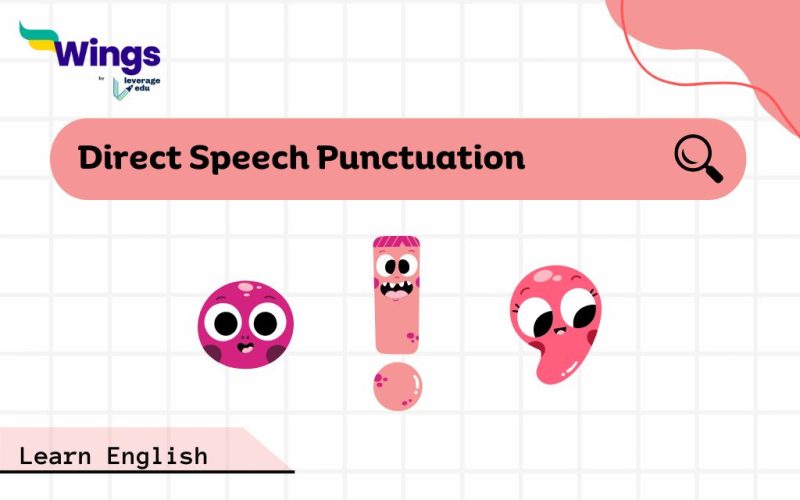Direct speech punctuation is used in reported speech to separate spoken words or dialogue from the rest of the sentence. Some of the common symbols used to punctuate direct speech are commas, inverted commas, exclamation marks and many more. Keep reading this blog hereon to know all about the reported speech punctuations and how they can be used with specific without committing any grammatical error.
This Blog Includes:
Learn All About Punctuation Here!
What is Direct Speech Punctuation?
When using direct speech punctuation in your writing, one can more clearly convey what someone said. To distinguish spoken words from the surrounding text, it employs a combination of quotation marks, capitalization, and commas.
List of Direct Speech Punctuation and Examples
Here is a list of direct speech punctuation marks with their examples.
Rules of Using Direct Speech Punctuation Marks with Examples
Take a look at the rules for using direct speech punctuation marks along with the examples to get a better understanding.
Using Commas in Direct Speech
Commas are key players in punctuating direct speech, they help in clarifying who’s saying what. Here are examples of how commas work through examples:
Comma after the Introductory Clause:
This is the most common scenario. When you introduce who’s speaking before their words, use a comma to separate them.
Example: “I’m going for a walk,” she said.
Comma before the Closing Quotation Mark:
If you introduce the speaker after their words, put a comma before the closing quotation mark.
Example: “I’m going to the store,” said my sister.
Double Commas with Interruptions:
If you interrupt the quoted speech with an attribution (who’s speaking), use a comma after the first part of the speech, another comma after the attribution, and then continue the quotation marks.
Example: “Wait a minute,” she interjected, “did you forget something?”
Commas and Question/Exclamation Marks:
Generally, you don’t need a comma after the quoted speech if it ends with a question mark or exclamation mark since the punctuation already indicates a pause. But, if the introductory clause comes first, the comma goes before the closing quotation mark (even with a question or exclamation mark).
Example: “Are you sure?” she asked.
Also Read: What is the Use of Commas (,): Meaning, Rules, & Examples
Using Question Mark Punctuation in Direct Speech
Question marks are indeed used in direct speech to indicate an interrogative sentence. Here’s how they work:
Direct Questions:
Whenever someone asks a question in quoted speech, you use a question mark within the quotation marks, regardless of the sentence structure around it.
- Example: “Where are you going?” he asked.
- Example: “Have you seen my keys?” she wondered.
Question Mark with Attribution:
If you introduce the speaker with a phrase before their question, the question mark remains inside the quotation marks, and a comma separates the introductory phrase.
Example: Confused, he asked, “What’s going on here?”
Also Read: Question Mark Punctuation (?): Definition, Usage, and Examples
Use of Exclamation Mark as Direct Speech Punctuation
Exclamation marks are just as important as commas and question marks when it comes to punctuating reported speech. Here’s how they function:
Exclamations in Speech:
Just like with questions, use an exclamation mark inside the quotation marks when the spoken words themselves express strong emotion or surprise.
- Example: “Look out!” she screamed.
- Example: “I won the lottery!” he exclaimed.
Exclamation Mark with Attribution:
Similar to questions, if you introduce the speaker with a phrase before the exclamation, the exclamation mark stays within the quotation marks, separated by a comma from the introductory phrase.
Example: Surprised, she shouted, “Get out of here!”
Also Read: 20+ Exclamation Mark examples in Sentences with Usage
Exercises on Direct Speech Punctuation

FAQs
If the direct speech is at the beginning of the sentence then you must put a comma before the final quotation mark.
Direct speech is a sentence where the exact words are put in speech marks also known as quotation marks.
Direct speech is surrounded by quotation marks. Indirect speech, on the other hand, is not surrounded by speech marks and is just written within the text.
Related Reads
This was all about direct speech punctuation, its rules, examples and related information. Hope you understand the concept and know how to proceed. You can also follow the Learn English page of Leverage Edu for more exciting and informative blogs related to grammar.
 One app for all your study abroad needs
One app for all your study abroad needs














 45,000+ students realised their study abroad dream with us. Take the first step today.
45,000+ students realised their study abroad dream with us. Take the first step today.

